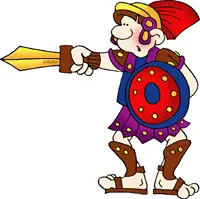Arch of Constantine
The ancient Romans liked to celebrate and build monuments after victories in a battle over their opponents during times of war. The Arch of Constantine is no different.
The structure was constructed to commemorate the victory of Emperor Constantine against the Roman tyrant Emperor Maxentius at the Battle of Milvian Bridge in Rome on the 28th of October 312 C.E.
The Roman triumphal arch is the largest surviving in Rome and was one of the last monuments of Imperial Rome.
The Battle of Milvian Bridge
The Battle of Milvian Bridge is significant for many reasons. Constantine’s army was half the size of the tyrant Emperor Maxentius who had taken control of Rome and Italy in 311 C.E. Before the battle, Constantine claimed to have a dream.
His dream included winning the battle if his soldiers entered battle and fought under the sign of the Christian Cross.
Before Constantine’s army entered battle that day, his soldiers painted a Christian Cross on their shields. Constantine and his soldiers dominated the battlefield and defeated Maxentius and his army.
One year later, Constantine declared himself a Christian after signing the Edict of Milan in 313 C.E. He became the Emperor of both the Eastern and Western Roman Empire in 324 C.E.
The Arch of Constantine
The Arch of Constantine was commissioned by the Roman Senate in 315 C.E., and construction started in the same year. The overall design of the arch is similar to the Arch of Septimius Severus that was built in the 203 C.E.
The Arch of Constantine is located between the Colosseum and the Palatine Hill along the Via Triumphalis, where the Emperors would enter Rome.
The arch itself is 69-feet in height (21 meters), 85-feet wide (26 meters), and the arch has a depth of 24-feet (7.4 meters). The structure is composed of three arches.
The middle arch is the largest with two smaller archways on each side.
The three archways are proportional and constructed of Proconnesian marble. The three arches are separated by large Corinthian columns made of Numidian yellow marble.
The arch has numerous designs, including battle scenes, hunting, sacrifices, and former Roman emperors like Hadrian.
The eight sculptures on the top are similar to the ones on the Forum of Trajan and include Dacian warriors being captured. Other famous figures on the arch include Marcus Aurelius, several pagan gods, and goddesses, including Apollo, Hercules, Silvanus, and Diana.
The inscription on the Arch of Constantine is inlaid gilded bronze inscribed in Latin. The inscription dedicated the arch to Constantine for his work as Emperor and as a leader of the Roman Empire.
Facts about the Arch of Constantine
- The Arch of Constantine was constructed in 315 C.E.
- The Arch of Constantine commemorates the victory of Emperor Constantine over the tyrant Emperor Maxentius at the Battle of Milvian Bridge in 312 C.E.
- Before the battle, Constantine had his soldiers paint a Christian Cross on their swords.
- The Arch of Constantine is the largest of the remaining three Triumphal arches constructed.
- The arch is located between the Colosseum and Palatine Hill along the Via Triumphal, where emperors entered the city of Rome.
- The arch is made from several different marbles, including Numidian and Proconnesian.
- The arch is 69-feet in height (21 meters) and 85-feet wide (26 meters). There are three archways with the center arch being the largest.
- Designs on the arch include scenes from famous battles, hunting, sacrifices to gods and goddesses, and several important historical figures like Hadrian and Marcus Aurelius.
- The inscription on the arch is dedicated to Constantine and is made of inlaid gilded bronze.
What did you Learn?
- In what year was the Arch of Constantine constructed?
315 C.E.
- The Arch of Constantine was dedicated to the victory of Constantine over which tyrant Roman Emperor?
Maxentius
- What symbol did the soldiers of Constantine paint on their shield before entering battle?
Christian Cross
- How many arches are incorporated into the Arch of Constantine?
Three
- What famous Roman Emperors are on the arch besides Constantine?
Hadrian and Marcus Aurelius



